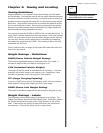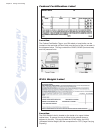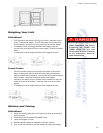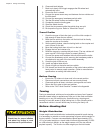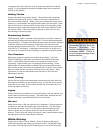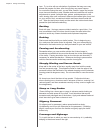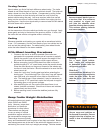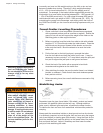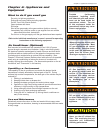
18
Chapter 3: Towing and Leveling
incorrectly can have too little weight resting on the hitch or pin and can
become unstable when towing. Therefore, a hitch weight percentage
of 10 – 15% for travel trailers and 20 – 25% for fth wheels must be
maintained. For example, if the loaded vehicle weighs 8000 pounds, the
hitch weight for a travel trailer should be between 800 – 1200 pounds (10
– 15% of the 8000 pound total). For a fth wheel this same 8000 pound
vehicle should have a pin weight of 1600 – 2000 pounds (20 – 25%). By
maintaining the correct hitch percentage and staying within the limits of
the GVWR and GAWR you can insure a safe towing experience with your
trailer.
Travel-Trailer Leveling Procedures
1. Chose a site that is level as possible (Some sites are equipped
with a prepared surface such as concrete or asphalt.) Ensure the
ground is not soft and will support the weight of the trailer on the
stabilizing jacks or other support devices.
2. Before uncoupling, level the trailer from side to side with suitable
lengths of 2” x 6” wood blocks under the trailer wheels. Place the
wood blocks on the ground forward of the wheels, and tow the
trailer onto the blocks. Block the wheels to be sure the trailer
cannot roll.
3. Put the foot pad on the hitch jack post, uncouple the trailer
from the tow vehicle and level the trailer front to rear. It may be
necessary to place a sturdy 2” x 6” wood block under the jack post
foot pad to support the jack post on soft ground surfaces.
4. Check the level of the trailer with a carpenter’s level both
crosswise and lengthwise on the trailer oor.
5. After stabilizing the trailer, be sure the trailer frame is not twisted,
buckled, or stressed. Check that all doors and windows operate
freely and do not bind.
6. Before resuming travel, be sure all stabilizers are removed or fully
retracted.
Stabilizing Jacks
Dependent upon the type (travel-trailer / fth-wheel), product and model
purchased, the stabilizer jacks included will vary. Although stabilizer
jacks come in different types and sizes, all perform the same function:
To stabilize the front and rear of all recreational vehicles while parked for
camping.
Always park the recreational vehicle on level ground and use tire chocks.
It is extremely important to level the trailer front and rear using the tongue
jack (travel-trailers) or landing gear (fth-wheels). Using the crank for the
particular stabilizer jack, lower the jack(s) on the lowest side of the trailer
rst and check the level. Adjust if necessary and then lower the other
jack(s) to nish stabilizing the trailer.
Stabilizing jacks are designed to
level and stabilize your coach.
Do not attempt to lift the unit to
change a tire or for any other
purpose.
After-market stabilizer stands
must be placed only under
chassis frame rails. Stabilizer
jacks should not be placed at
extreme corners of the frame.
Locating stabilizers in these
locations can cause slide-room
damage if leveling blocks were
to shift or settle. Do not attempt
to level, raise or otherwise
place all of the weight of the
unit on the stabilizer jacks. Do
not use stabilizer jacks for tire-
changing.
Note



